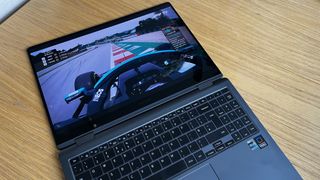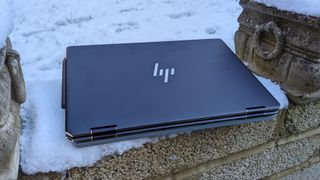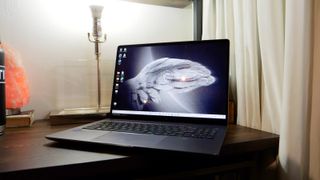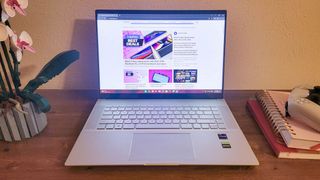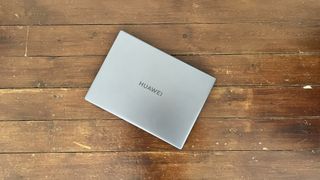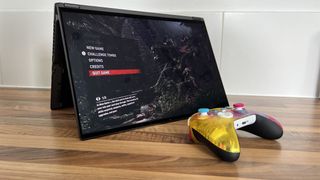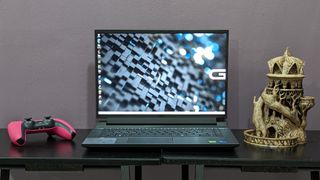The best 16-inch laptops offer a tight balance between affordability and quality, all while alluring us with its moderately-sized display designed for those who can’t be asked to decide between a tiny 13-inch screen and an absolute monster of an 18-inch laptop. Why struggle when you can strike a solid middle ground?
Regardless of if you’re seeking a laptop for business, productivity, or gaming, we have something on this list that will appeal to you, even if you’re in need of a quality 2-in-1.
But what makes a good 16-inch laptop? We’re going to cover how we measure price tag against a display’s color depth and brightness, performance metrics across gaming and productivity, the allure of its exterior, the quality of its make, and how it compares to competitors in both longevity and coolness.
If you’re shopping on a budget, be sure to check out our best laptops under $1.500 and best cheap laptops pages for the best deals on the market.
And if you’re in the market for a peripheral or two, take a gander at our pages for best gaming headsets, best gaming mouse, best gaming monitors and best gaming keyboard.
The best 16-inch laptops you can buy today
Why you can trust Laptop Mag
Our expert reviewers spend hours testing and comparing products and services so you can choose the best for you. Find out more about how we test.
The Samsung Galaxy Book 3 Pro 360 showcases the company’s design at its best, showing users that Samsung finally understands how to deliver a phenomenal laptop without too many compromises. While we felt the previous two Galaxy Books were solid enough and boasted ambitious ideas, they didn’t fully live up to what we wanted. This third iteration, however, subverted expectations and completely blew us away.
The most exciting changes begin with a powerful 13th Gen Intel Core i7-1360P CPU and a 16-inch, 16:10 display, as its impressive performance metrics make for a faultless productivity experience. And of course, if you’re someone who enjoys a big screen to get your work done on a thin-and-light frame, you won’t come out disappointed.
However, the Galaxy Book 3 Pro 360 is far from perfect. Out of everything Samsung has iterated upon when compared to last year’s model, those improvements have come with an unfortunate risk to the laptop’s battery life. Lasting only 7 hours and 46 minutes, it sinks far below survivability when compared to its competitors. And while the laptop boasts alluring color depth, we were rather unimpressed with its brightness score of 380 nits, which is more than 100 below what the MacBook Air M2 has going for it.
Regardless, the Samsung Galaxy Book 3 Pro 360 is an absolute powerhouse. And best of all, its competitive price of $1,399 makes it a solid contender when compared to the best productivity laptops out there.
See our full Samsung Galaxy Book 3 Pro 360 review.
I won’t sugarcoat it: The MacBook Pro 16-inch is the most expensive laptop on this list. You’re looking at Apple’s most powerful laptop to date, additionally standing tall as one of the best laptops ever crafted overall. Boasting the longest lasting battery life that Laptop Mag has seen in any modern laptop at 18 hours and 56 minutes, alongside performance that could make any hardware-fanatic weep tears of joy, this is a terrifying monstrosity.
But that’s where things become challenging, as the model of the MacBook Pro 16-Inch M2 Max that we tested goes for $5,299. That’s an absurd price that will not appeal to a vast majority of consumers, but if you’re one of the few who looks at this and goes “gimme gimme,” you won’t be disappointed. Or, you can look into acquiring the $2,699 base model, which is still expensive, but more infinitely more affordable.
Our performance tests did not let us down, with the M2 Max offering performance scores that demolished its competition and category averages. Its SSD is also blisteringly fast with a 5,717MBps read speed and 6,665MBps write speed. And while it cannot match a discrete GPU, its gaming performance shocked us, with our reviewer running Resident Evil Village at Ultra settings for 68 frames per second. Overall, you will be in awe at how powerful this absolute beast can be.
We were, however, surprised to see that the display’s color depth was a tad bit below our premium laptop average. We expect more from a laptop at $5,299, but it certainly makes up for this fault elsewhere, especially with a display brightness that goes as high as 447 nits.
See our full MacBook Pro 16 review
If you’ve ever wondered “what’s the most powerful gaming laptop I can get my hands on,” the Asus ROG Zephyrus M16 is a pretty good answer. Packing a Intel Core i9-13900H processor, Nvidia GeForce RTX 4090 GPU, 32GB of RAM, 2TB of SSD storage, and a 16-inch, QHD+, 240Hz, Mini LED display, this beast puts every other gaming laptop to shame. It’s safe to say Asus has manufactured the embodiment of “premium gaming laptop.”
With specs of this absurdity, you might not be surprised to learn that the Zephyrus M16 needs to be plugged in often. We do not have lab results, but our very own Jason England tested a session of Cyberpunk 2077 with high settings and only lasted 42 minutes. Through non-gaming tests, it couldn’t survive more than a few hours, which isn’t surprising considering this thing packs a 4090.
We’re not joking when we say this thing is premium. You’ll be paying a total of £4,099 if you want the model we tested. We shouldn’t have to say that’s absurdly expensive, so we’re not going to pretend that this is a consumer-level gaming laptop by any means. This is for folks willing to spend lots of money, as its price point far exceeds how much you’d pay if you were ever trying to build a top tier gaming desktop.
But with its ability to hover around 60fps on Cyberpunk 2077 at 2K resolution with graphic settings on ultra and ray tracing on, it’s hard to say no to those results. A select few laptops can ever claim to accomplish such a feat, and the Zephyrus M16 is one of them, making it one of the best Asus laptops on the market.
See our full Asus ROG Zephyrus M16 review.
The HP Spectre x360 16 is nothing to scoff at, as we were absolutely stunned by its 16-inch OLED touchscreen, stylishly compact design, immersive Bang & Olufsen audio, and comfortable keyboard. Sounds like perfection, right?
Well, although this dazzling 2-in-1 laptop is one of our favorites of its kind, and deserves its spot here and on the best HP laptops as well as the best 2-in-1 laptops page. there are a few things it could do better. Performance is its biggest issue, as although our tests showcased a quality effort in Geekbench 5 score and the HandBrake benchmark, it could not quite match up to what competitors were bringing to the table. At the very least, the Spectre x360 16 has a phenomenal SSD with blisteringly fast performance.
You might be wondering, “if the performance is good but not great, what makes this laptop one of the best out there?” Being a 2-in-1 laptop puts it in a position where it benefits from dynamic usage, but beyond that, the Spectre’s 16-inch, UHD+ (3840 x 2400) OLED display is breathtaking.
Combined with the crisp and clear speaker system, this is an amazing laptop for those with strict tastes insofar brightness and color depth go. Sure, the performance could be better, but the Intel Core i7-1260P processor offers enough power to make this a great laptop for those with a discerning eye and ear, all wrapped up in an exterior that oozes sleekness.
See our full HP Spectre X360 16 (2022) review.
The MSI Creator Z16P is another laptop, like the Asus ROG Zephyrus M16, with a focused consumer base. With specs as ludicrous as an Intel Core i9-12900H processor, Nvidia GeForce RTX 3080Ti with 12GB VRAM, 64GB of RAM, 2TB of SSD storage and a 16-inch QHD (2560 x1600) 165Hz display, this beast is not for the faint of heart.
It’s no surprise that specs of this potency comes with a steep cost. Yes, the model of the Creator Z16P we tested will cost you $4,299 and is one of the best workstations you can get your hands on. We also adored its simple but elegant all-aluminum Lunar Gray chassis.
It’s not surprising that this display as mesmerizing as it is, with a phenomenal color depth that exceeds far beyond the average workstation (which better be the case considering its price), although it didn’t look quite as poppy as competitors like the ZenBook Pro Duo.
Performance is the Creator Z16P’s specialty, with a Geekbench 5.4 score that is not only more than double the workstation average, but also left its competitors so far in the dust that the laptop might as well have been in a different race. The same can be said for its performance in the Handbrake benchmark and file transfer tests, easily surpassing competition and smashing averages.
It’s safe to say that if you’re concerned about speed, MSI has not disappointed with this workstation. This performance comes with a cost, however, as our biggest issue comes down to its 5-hour battery life. Still, it’s one of the best MSI laptops on the market.
See our full MSI Creator Z16P review.
The HP Envy 16 is a premium laptop that can handle productivity tasks phenomenally, while also boasting a powerful enough GPU for those interested in moderate gaming. It’s also one of the best HP laptops you can buy.
It boasts an Intel Core i9-12900H processor, Nvidia GeForce RTX 3060 GPU with 6GB of VRAM, 32GB of DDR5 RAM, 2TB of SSD storage, and a 16-inch 3840 x 2400-pixel OLED display with a 60Hz refresh rate. These specs coalesce into a package that can do anything you need it to but the positives go beyond just that.
If you’re anything like me and deeply care about color, the Envy 16 has you covered, reproducing 138{fa54600cdce496f94cc1399742656d2709d9747721dfc890536efdd06456dfb9} of the DCI-P3 color gamut with its 4K OLED display. Few laptops can get even close to this value, and although its brightness isn’t the greatest, it’s still more than enough that anything you watch will gloriously melt your eyes.
It’s not without flaw, however, as even though it merely features an RTX 3060, the battery life while gaming is poor, lasting only 1 hour and 20 minutes in our gaming tests. This wouldn’t be quite as offensive with a more powerful graphics card, but if you plan on playing anything, we recommend keeping it plugged in unless you don’t mind the stress of losing your progress every hour-or-so.
We also noticed the lack of an ethernet port, which won’t be a deal breaker for everyone, but a stable internet connection while working, especially when uploading or downloading, is often vital.
See our full HP Envy 16 review.
We came away from the Huawei MateBook 16s stunned by its 12th Generation Intel performance, strong battery life, stunning display, and cool thermals. Alongside a smooth touchpad and tactile keyboard, we found that this productivity laptop did a great job throughout a workday.
And at a starting price of £1,299, you’re being graced by powerful hardware at a cost that is a good bit cheaper than some of its biggest competition—like the MacBook Pro 14. Unfortunately, if you’re in America, you can’t get your hands on the MateBook 16s officially, but it’s still worth the recommendation for those who can.
The MateBook 16s comes packed with a Intel Core i7-12700H or i9-12900H, 16GB of RAM, 1TB of SSD storage and a 16-inch, 2520 x 1680-pixel resolution, giving it more than enough power to handle your workflow. On our GeekBench 5.4 tests and Handbrake benchmark, we found that the laptop performed significantly above our laptop averages in performance, even boasting an SSD running at 1,323MBps, which is nearly 500MBps over our category average.
It’s not a perfect laptop, however, as we wish it boasted a dedicated GPU model, a number pad, a lighter weight overall and an improved webcam. These issues do not detract from its phenomenal qualities elsewhere, but it is important to keep in mind if you plan to purchase it.
See our full Huawei MateBook 16s review.
Oh great, another expensive gaming laptop. Such joy! I won’t pretend that this laptop isn’t expensive, but at the very least, it’s not going to cost you upwards of $4,000-$5,000 like the Asus ROG Zephyrus M16. Starting prices for the Asus ROG Flow X16 land at $2,000, while the version we tested is currently available for $2,699.
For that price, you can get your hands on a AMD Ryzen 9 6900HS processor, Nvidia GeForce RTX 3070 Ti GPU, 16GB of RAM, 1TB of SSD storage, and a 16-inch 1440p touchscreen Mini LED display at a 165Hz refresh rate. Plain and simply, this is some serious power for a price that’s not too unbelievable.
But I haven’t quite revealed the big gimmick here: The Flow X16 not only features a touchpad display, but it also boasts a 360-degree hinge, allowing it to shift into a self-supporting mini monitor on the fly. Connect a game pad to this thing and you can game nearly anywhere.
This 2-in-1 versatility makes it an excellent on-the-go laptop, and although its gaming performance doesn’t quite match up to some of its competitors, this feature makes it stand out amongst the bunch. However, this versatility isn’t quite as flooring when away from a charging station, as its gaming battery life is around 1 hour and 4 minutes.
See our full Asus ROG Flow X16 review.
Oh finally, a quality 16-inch gaming laptop that doesn’t cost a fortune. Packing a Intel Core i7-12700H processor, Nvidia GeForce RTX 3060 graphics card, 16GB of RAM, 512GB of SSD storage and a 16-inch, IPS 2560 x 1600-pixel display with a 165Hz refresh rate, the Dell G16 is a powerful gaming laptop that we only tested for $1,499.
We’re not going to sell the G16 as a miracle laptop, but its performance metrics are pretty impressive considering it managed to survive decently against its more expensive competitors without falling too far behind. It’s also important to keep in mind the RTX 3060 GPU has 6GB of VRAM, which means you will be limited to how high you can set your graphic settings.
It’s far from perfect, however. The Dell G16’s abysmal color depth is my biggest pet peeve personally, as any and all gamers deserve to see the hues of the environments, characters and effects represented with as much depth and accuracy as possible. But the laptop falls behind competitors, reproducing only 75.3{fa54600cdce496f94cc1399742656d2709d9747721dfc890536efdd06456dfb9} of the DCI-P3 color gamut, which means you won’t be wowed by this screen.
Other flaws include mediocre battery life at only four hours in non-gaming mode, weak speaker system that emits each sound at a muffled consistency, and a chassis that runs a little too hot during gaming sessions.
See our full Dell G16 review.
How we test gaming laptops
When we bring a laptop into our laboratory, our goal is to see how it would work if you brought it into your home or office. While we use a number of industry standard benchmarks such as Geekbench and 3DMark, we focus heavily on real-world tests that we have developed in-house.
To test endurance, the Laptop Mag Battery test surfs the web at 150 nits of brightness until the system runs out of juice. To judge pure processing power, we use a giant spreadsheet macro that matches 65,000 names with their addresses, a video transcoder that converts a 4K video to 1080p and the Geekbench 5 synthetic test. We measure graphics prowess with both 3DMark Ice Storm / Fire Strike and a series of actual game titles.
We use a colorimeter to measure screen brightness and color gamut while other instruments help us determine a laptop’s key travel and ambient heat. See this page on How We Test Laptops for more details on our benchmarking procedures.
How to find the right 16-inch laptop for you
What makes a 16-inch laptop good is not much different than what makes any other laptop good. You need to question if the price being asked of you is worth what it can offer, and there are many factors that determine whether or not that is the case. Battery life, performance metrics, display color depth and brightness, thermal efficiency, aesthetic, sturdiness, and unique gimmicks all funnel into what makes a laptop worth the purchase.
Samsung Galaxy Book 3 Pro 360 balances each of these elements solidly while packed in a decently priced product at $1,399, offering great performance metrics in an ultra-light weight frame with 2-in-1 functionality. If you’re looking for a great 16-inch laptop without breaking the bank, this is an excellent pick.
But if “breaking the bank” is your motto for some reason, you can take a look at the MacBook Pro 16-inch (M2 Max). With nearly 19 hours of battery life, 96GB of RAM, 4TB of SSD storage, and performance metrics that will make you literally sob, you’d think this is the laptop of dreams. That is until you see its $5,299 price tag. If you’re somehow still considering buying this thing, I commend your resolve.
The Asus ROG Zephyrus M16 and MSI Creator Z16P also fulfill the “break the bank” criteria, although the former is of the gaming laptop variety, while the latter is an intense workstation. Both feature incredible specs and can run guns at high framerates, but once again, this is costing you around $4,000-$5,000.
If you’re in need of a less expensive gaming laptop, the Dell G16 is $1,399 and offers solid performance all around. You won’t get anything as impressive at the more expensive alternatives, but at the very least, you can expect high framerates at moderate graphic settings on most titles.
Asus ROG Flow X16 is probably the coolest entry on this list, as it’s a 16-inch gaming laptop with 2-in-1 functionality, which means you can pull it out on the go, connect a gamepad, prop the screen up and just play whatever you’d like on the spot. Yes, it’s $2,699, which isn’t cheap, but those who enjoy this novel idea will probably get a kick out of it.
The HP Envy 16 is similar to the Galaxy Book 3 Pro 360 in the sense that it is an all-around great pick, except it’s on the more expensive end at $2,799. This is absolutely worth it if you can afford it though, as it’s a miracle laptop that’s pretty much good at everything from productivity performance to gaming to display color depth. You won’t love the battery life, but it’s not all that bad.
The HP Spectre x360 16 is another great 2-in-1 laptop with a stunning visual design and amazing internal specs, although we found it was a little bit heavy to make tablet mode comfortable. But with a stunning OLED display, long-lasting battery life, phenomenal speaker system and all-around solid performance, it’s hard not to appreciate this thing.
Why trust Laptop Mag
Laptop Mag has been testing and reviewing laptops for over two decades. We test over 150 different models per year, subjecting each system to a series of rigorous benchmarks that provides a complete picture of performance, battery life and usability.
Our expert reviewers also use each product to see how it looks and feels in everyday situations. Because we see so many different notebooks, we can compare each to its direct competitors and give you an idea of how it stacks up to the average laptop in its price band.
